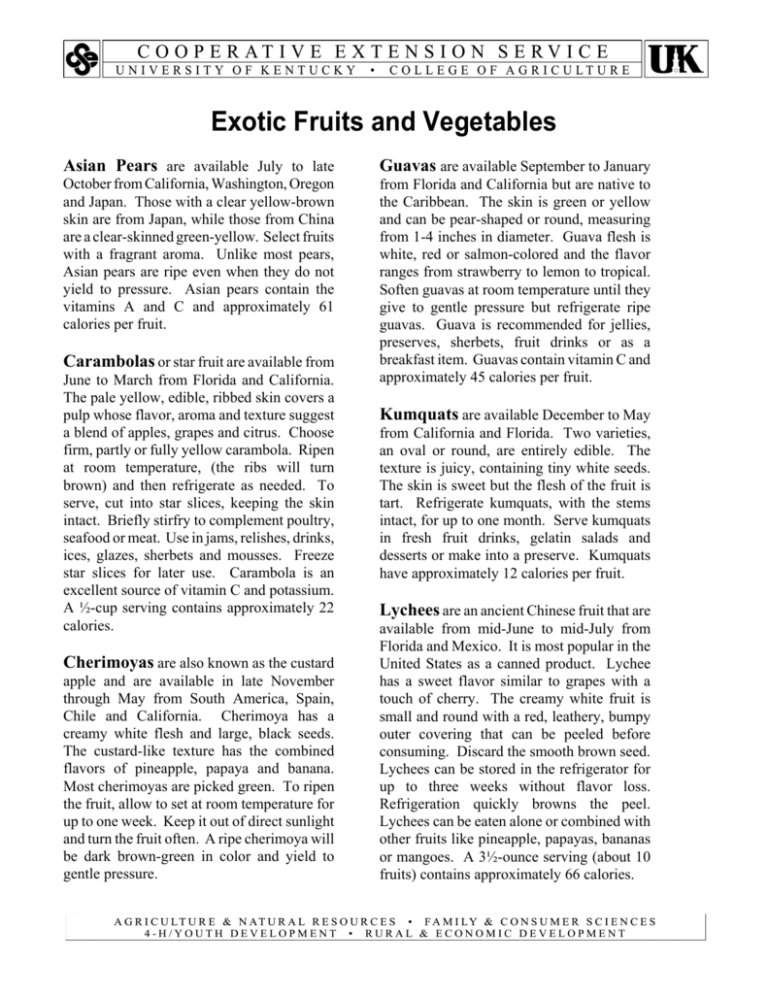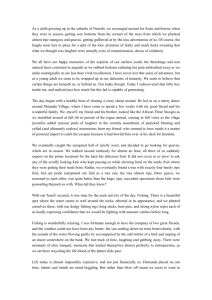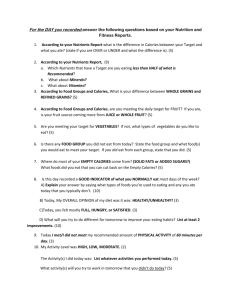Exotic Fruits and Vegetables
advertisement

Exotic Fruits and Vegetables Asian Pears are available July to late October from California, Washington, Oregon and Japan. Those with a clear yellow-brown skin are from Japan, while those from China are a clear-skinned green-yellow. Select fruits with a fragrant aroma. Unlike most pears, Asian pears are ripe even when they do not yield to pressure. Asian pears contain the vitamins A and C and approximately 61 calories per fruit. Carambolas or star fruit are available from June to March from Florida and California. The pale yellow, edible, ribbed skin covers a pulp whose flavor, aroma and texture suggest a blend of apples, grapes and citrus. Choose firm, partly or fully yellow carambola. Ripen at room temperature, (the ribs will turn brown) and then refrigerate as needed. To serve, cut into star slices, keeping the skin intact. Briefly stirfry to complement poultry, seafood or meat. Use in jams, relishes, drinks, ices, glazes, sherbets and mousses. Freeze star slices for later use. Carambola is an excellent source of vitamin C and potassium. A ½-cup serving contains approximately 22 calories. Cherimoyas are also known as the custard apple and are available in late November through May from South America, Spain, Chile and California. Cherimoya has a creamy white flesh and large, black seeds. The custard-like texture has the combined flavors of pineapple, papaya and banana. Most cherimoyas are picked green. To ripen the fruit, allow to set at room temperature for up to one week. Keep it out of direct sunlight and turn the fruit often. A ripe cherimoya will be dark brown-green in color and yield to gentle pressure. Guavas are available September to January from Florida and California but are native to the Caribbean. The skin is green or yellow and can be pear-shaped or round, measuring from 1-4 inches in diameter. Guava flesh is white, red or salmon-colored and the flavor ranges from strawberry to lemon to tropical. Soften guavas at room temperature until they give to gentle pressure but refrigerate ripe guavas. Guava is recommended for jellies, preserves, sherbets, fruit drinks or as a breakfast item. Guavas contain vitamin C and approximately 45 calories per fruit. Kumquats are available December to May from California and Florida. Two varieties, an oval or round, are entirely edible. The texture is juicy, containing tiny white seeds. The skin is sweet but the flesh of the fruit is tart. Refrigerate kumquats, with the stems intact, for up to one month. Serve kumquats in fresh fruit drinks, gelatin salads and desserts or make into a preserve. Kumquats have approximately 12 calories per fruit. Lychees are an ancient Chinese fruit that are available from mid-June to mid-July from Florida and Mexico. It is most popular in the United States as a canned product. Lychee has a sweet flavor similar to grapes with a touch of cherry. The creamy white fruit is small and round with a red, leathery, bumpy outer covering that can be peeled before consuming. Discard the smooth brown seed. Lychees can be stored in the refrigerator for up to three weeks without flavor loss. Refrigeration quickly browns the peel. Lychees can be eaten alone or combined with other fruits like pineapple, papayas, bananas or mangoes. A 3½-ounce serving (about 10 fruits) contains approximately 66 calories. Mangoes are available year-round in many Plantains are available year-round from varieties, shapes and sizes. Peel the reddishyellow skin to expose the ripe, juicy yellow pulp. A ripe mango will give slightly to the touch and have a light mango aroma at the stem end. Allow fruit to ripen at room temperature. Pureed mango can be added to drinks, desserts, sauces and salad dressings. Cubed mango may be sprinkled with lime juice or sugar and frozen for later use. Mango is high in the vitamins A and C. Ecuador and Mexico. It is slightly acidic and squash-like in taste. The skin is thick with a salmon-colored pulp which sweetens as it ripens. The fruit must be cooked. Green plantains are often used in stews while ripe plantains can be sliced and fried. Even when the skin is black, the plantain is ideal for dessert recipes. Store in a cool, dry place for up to three weeks. The yellow-fleshed variety contains vitamin A and a 3½-ounce serving has approximately 119 calories. Papaya is available year-round. Except for its yellow-green skin, it resembles an avocado in shape, with a solid, bright reddish-orange pulp and soft, black, non-edible seeds. Allow papaya to ripen at room temperature until the color changes from green to yellow gold. A ripe papaya will have a soft fruity aroma. Pureed papaya is good in dressings, marinades, tropical drinks and yogurt. Papaya chunks may be cooked in meat, fish and poultry dishes. Papaya is high in vitamin C and a good source of fiber. Passion Fruit, native to Brazil, is the edible fruit of the passion flower. Early Spanish missionaries named the fruit in honor of the passion of Christ. The fruit is available yearround from either New Zealand, Florida or California. It is a small round fruit the size of a large egg with wrinkled, red, yellow or purple-brown skin. The yellow flesh and small black edible seeds have an intense aromatic flavor while the texture is jelly-like and watery. Passion fruit is ripe when the skin is wrinkled and looks old. A 3½-ounce serving contains the vitamins A and C, potassium and approximately 90 calories. Tomatillos are available year-round from Mexico and California. The tomatillo has a papery covering of a fruit resembling a green cherry tomato. The solid, seedy flesh has a slight, sweet apple or plum flavor that is enhanced by cooking. Store in a cool, dry area. Select fruit that is hard and does not give like tomatoes. Traditional uses include steaming and adding to salsas, Mexican stews and casseroles. They are the base of salsa verde or green sauce. A ½-cup serving of tomatillo contains the vitamins A and C and niacin with approximately 50 calories. Ugli fruit is a native of Jamaica and available December through April. It is thought to be a cross between a tangerine and a grapefruit so the thick, loose skin peels very easily to reveal sweet yellow-orange sections with few seeds. Uneven coloring, bronzing or scarred skin is normal and because of its thick skin may be stored in the refrigerator for up to two weeks. Choose and use ugli fruit like a grapefruit. It is high in vitamin C. Belgian Endive has a white head of yellow-tipped, closely wrapped leaves. It has a mild, bitter flavor. Belgian endive is packaged in opaque containers and should be refrigerated. A 3½-ounce serving of Belgian endive provides fiber, iron and potassium and approximately 15 calories. Page 2 Bok Choy is an Oriental cabbage that has Daikon is also known as the Japanese or thick, white stalks that support large, spoonshaped dark green leaves. When cooked, Bok Choy is tender and sweet, yet crisp. Large leaf bok choy can be used in soups. Refrigerate unwashed bok choy in perforated plastic bags for up to three days. A ½-cup serving of bok choy contains the vitamins A and C, calcium and has approximately 15 calories. Oriental radish. It resembles a white carrot and is sweet, juicy and slightly hotter than the traditional radish. It weighs 1-2 pounds and averages a food long. Daikon can be added to relishes and salads. Daikon should be refrigerated. A 3½-ounce serving of uncooked daikon contains about 19 calories. Calabaza is a hard-shelled squash that is a native American product available yearround. Calabaza is round to pear-shaped and comes in several sizes with a mottled green to buff-colored skin. The flesh is bright orange with a fine-grained, sweet, moist texture. Calabaza can be cut and then refrigerated for up to a month. Calabaza is a popular ingredient in Caribbean and West Indies cooking and can be substituted for other squashes in recipes. A 1-cup serving of the cooked Calabaza contains vitamin A and approximately 35 calories. Flowering Kale is often referred to as ornamental cabbage. It has large, wrinkled leaves of either a purple or cream color laced with green trim. Flowering kale has a milder flavor than cabbage and can be used in salads, steamed, boiled or used in stir-fry. Flowering kale contains vitamins A and C, potassium, calcium and iron and approximately 50 calories. Jerusalem artichoke or Sunchoke is a root tuber. Tan to cream in color, Sunchokes can be smooth and pearly but often are lumpy and bulbous. The Jerusalem artichoke is similar to ginger root in size and color. The flesh is crisp like water chestnuts. Refrigerate and thoroughly scrub the vegetable to remove any sand or soil. It can be used in vegetable salads or meat or fish dishes. A ½-cup serving contains iron, phosphorous and Bvitamins and approximately 60 calories. Jicama is also known as the Mexican potato. Jicama is brown skinned with a white flesh of a delicate, slight sweet flavor. It is a root tuber that should be smooth and firm with relatively unblemished roots. If jicama is large or becomes shriveled, cut it into pieces. Refrigerate the vegetable, unwrapped for up to three weeks. Once cut, it can be covered by plastic and used within one week. Jicama can be served cold and raw or in soups, stews or salads. It can also be used as a substitute for water chestnuts. A 3½-ounce serving contains vitamin C and approximately 45 calories. Kohlrabi is also known as the cabbage turnip. Kohlrabi is characterized by a swollen stem and a delicate, turnip-like flavor that is either green or purple. Wrap and refrigerate kohlrabi for up to one week. Kohlrabi leaves can be eaten raw in salads or steamed. Cook the bulbs as you would turnips. A one-cup serving of kohlrabi contains vitamin C and potassium with approximately 40 calories. References *websites accessed February 12, 2002 -Brooks Tropicals: www.brookstropicals.com -Grigson, J. & C. Knox. Cooking with Exotic Fruits & Vegetables. Holt: NY; 1986. -The Packer: www.thepacker.com -Van Den Berg, O. The Exotic Fruit & Vegetable Handbook. Hamlyn: NY; 2001. By Sandra Bastin, Ph.D., R.D., L.D. Food and Nutrition Extension Specialist Educational programs of the Kentucky Cooperative Extension Service serve all people regardless of race, color, age, sex, religion, disability, or national origin. Issued 7-1995 Revised 2-2002; FN-SSB.026 Page 3








